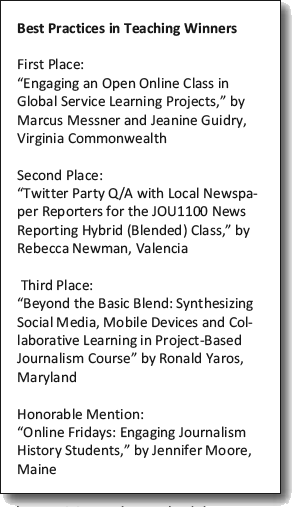Capturing Students’ Attention
 By Leslie-Jean Thornton
By Leslie-Jean Thornton
AEJMC Standing Committee on Teaching
Associate Professor
Barrett Honors Faculty
Cronkite School of Journalism and Mass Communication
Arizona State University
Leslie-Jean.Thornton@asu.edu
(Article courtesy of AEJMC News, November 2015 issue)
Here’s what I remember: After 15 minutes of a lecture, students start to glaze over, attention-wise. After 30 minutes, they’re genuinely antsy with brains in rebellion. And at the dreaded 45-minute mark, they’re actually losing knowledge, and will leave the lecture less smart than they were when the lecture began. This was the highly memorable advice I recall from a teaching bootcamp I attended a decade ago. It may not be exactly accurate, but… it’s a cautionary tale. I often think of it when I’m at a conference and the speaker’s gone on too long. As I fight to focus, I’m pretty sure I feel smarts escaping out my ears.
A variety of studies have weighed in on the attention span issue, including a recent one widely sourced as being from the National Center for Biotechnology Information. It famously reported that humans now have an average attention span of 8.25 seconds, three-quarters of a second less than that of goldfish and 3.75 seconds shorter than what humans averaged in 2012. When I tried to track this down, however, I found a range of attributions, squishy research dates and nothing in the way of solid data. So consider it another one of many comments on how external stimuli are encroaching on our abilities to — wait, what?
The general consensus, in terms of workable information, is that the most attentive a student will be is at the beginning of a class, after a brief settling-in period. Then attention will come and go in ever-decreasing amounts of time — unless interrupted by something that is interesting, refreshing, or otherwise engaging. A question will often do it, or a demonstration. But much depends on a host of variables, many of which are out of a professor’s control. A class’s stay-on-task potential, as any teacher can tell you, is inversely related to the proximity of holidays and semester breaks.
The lecture mode of teaching has come in for hard knocks in recent times, partly as a result of genuine research into how people learn, and how long they can pay productive attention. Still, in the right hands and for the right class, and by employing some keep-them-attuned tips, it can be one of many powerful methods. A key factor in teaching effectiveness is how appropriate the delivery method is to what is being taught. If you’re teaching a complex skill — how to create an interactive digital infographic, say — you’re going to want to go step by step, pausing often to let material sink in, and reinforcing it with “doing” (that would be the students) and showing (that would be you).
Take advantage of the “settling in” period. In those first few minutes of class, connect with the students in some way. This might be asking the class at large how their weekends went, telling them a lighthearted piece of news about yourself, or relaying some breaking news you heard on the way in and asking them if they know anything more. Direct their focus toward you, the teacher, in a way that makes them want to absorb what you say. During the settling-in time, expect them to wrap up their own conversations and do whatever’s needed to prepare for a productive time in class. Bonus: It tends to relax the professor, too. Caution: Don’t announce important information during this time if you can avoid it. If you do, expect to repeat it so that they hear it during a clearly designated pay-attention time.
The idea of “chunking” information, or delivering it in neat packages of easily absorbed units of time and complexity, can apply to all presentation genres. The increasing use of videos for online instruction has spurred inquiry into best practices. Good results are reported for videos that clock in under 10 minutes, and I’ve seen substantive points made in half that time. Of course, the advantage there is that students can replay segments when they want to clarify or review. In real life, it’s there and it’s gone. Traditionally, notes are the review materials, but they’re only good if the student taking the notes knows what’s going on when the notes are taken. Offering material incrementally, pausing to let students absorb each stage, and helping them stay clearly focused is just part of basic good teaching.
So what are some tips for that “clearly focused” part?
It might sound counter-intuitive in light of many, many complaints about technology and social media encroaching on class time and attention, but why not harness some of that to your own ends? Keeping in mind that a change in pace every 10 or 15 minutes is beneficial, and that engaging your students wakes them up and gives them “buy in” to what you’re doing, think about information races. Ask a question and see how long it takes for them to come up with answers — good, credible answers — using their smart phones or computers.
If your class lends itself to sending students outside of the classroom, work in movement breaks. Teaching reporting? Give them 15 minutes to go out and find a story seed after taking about 15 minutes to explain what you mean. Have them take notes with their cellphone cameras, or record a mini-interview with the same device. Then, once back in class, explain how that can be used in what you intended to teach them all along. Have them work at it for awhile, then, informally, have several students share their experiences. Then perhaps it’s time for another 15-minute session where you explain the next step…
Working in modules works. The key is another one of those teaching-skill tricks: matching the complexity of what you’re teaching to the complexity your students can handle at the time. But that’s another column.


